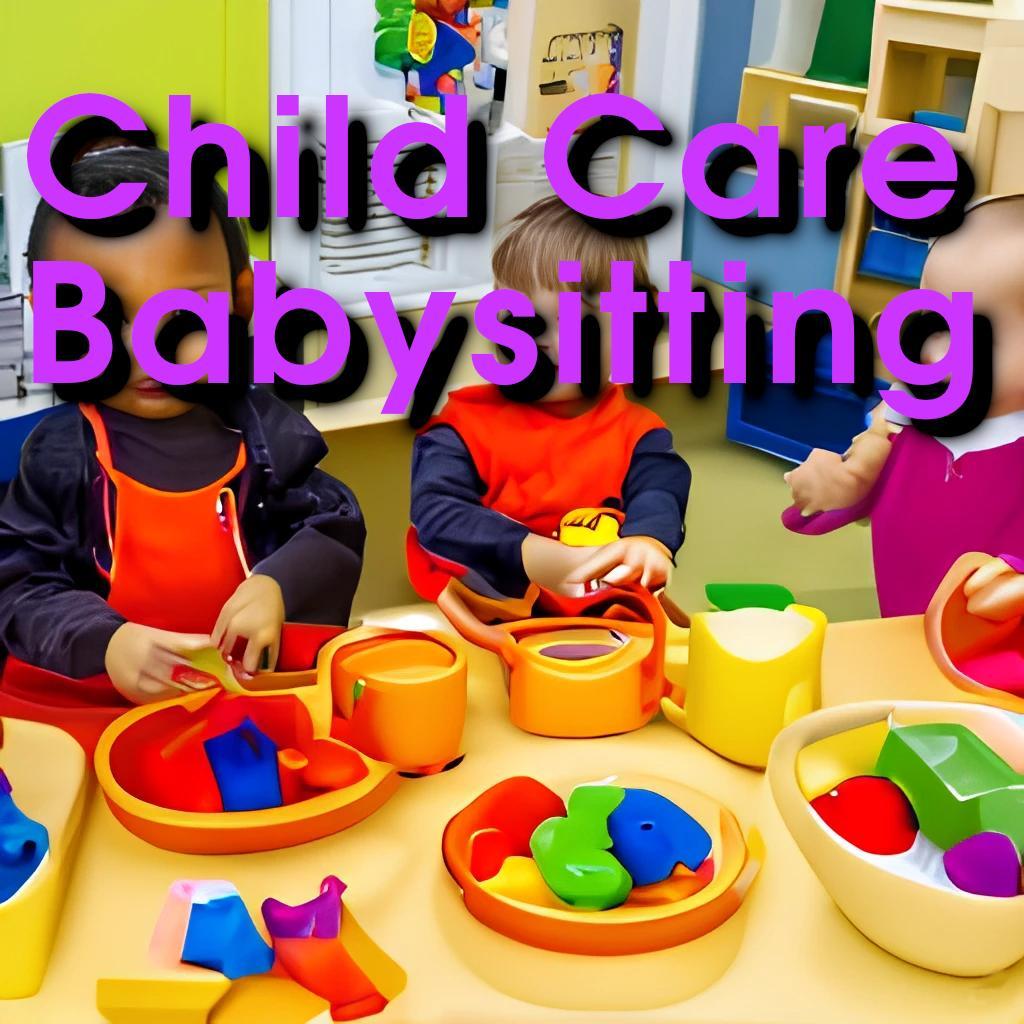


Child care and babysitting are rewarding but demanding responsibilities that require a unique set of skills and knowledge. Ensuring the safety, happiness, and well-being of children requires a combination of preparation, patience, and genuine care. In this guide, we will explore essential child care and babysitting tips to empower caregivers and provide a nurturing environment for children.
Child Care at Home.
Tip: Before babysitting, conduct a thorough childproofing of the environment. Identify potential hazards such as sharp objects, electrical outlets, and small items that could be choking hazards.
Establishing Routines:
Tip: Children thrive on routine. Work with parents to understand the child's daily schedule, including meal times, nap times, and play activities, and stick to it as closely as possible.
Effective Communication:
Tip: Maintain open communication with both the child and the parents. Establishing trust is crucial for a positive caregiving experience.
Emergency Preparedness:
Tip: Familiarize yourself with emergency contact information, including parents' phone numbers, nearby hospitals, and the child's medical history. Be prepared for various scenarios and know basic first aid.
Engaging Activities:
Tip: Plan age-appropriate activities to keep children engaged. This could include arts and crafts, storytelling, outdoor play, or educational games that stimulate their development.
Healthy Snacking:
Tip: Encourage healthy eating habits by providing nutritious snacks. Be aware of any allergies or dietary restrictions the child may have.
Positive Discipline:
Tip: Use positive reinforcement and redirection instead of punitive measures. Understand the child's emotions and communicate effectively to address challenging behavior.
Encourage Independence:
Tip: Foster independence by allowing children to complete age-appropriate tasks, such as dressing themselves or cleaning up their toys. This builds confidence and a sense of responsibility.
Meet and Greet:
Tip: Before babysitting, arrange a meet-and-greet with both the child and parents. Establishing a connection helps build trust and familiarity.
Detailed Information:
Tip: Request detailed information about the child's routine, allergies, and any specific needs. Make sure you have access to emergency contact numbers and know the home's layout.
Arrive Prepared:
Tip: Bring a bag with essentials such as snacks, games, and a first aid kit. Familiarize yourself with the location of emergency supplies like fire extinguishers and first aid supplies.
Clear Communication:
Tip: Establish clear communication with parents about rules, expectations, and any concerns they may have. Regularly update them on the child's activities and well-being.
Safety First:
Tip: Prioritize safety at all times. Be vigilant about the child's surroundings, and ensure they are secure, especially when engaging in outdoor activities.
Fun and Educational Activities:
Tip: Plan activities that are not only fun but also educational. Incorporate games and projects that stimulate creativity and learning.
Bedtime Routine:
Tip: Respect and follow the child's bedtime routine established by the parents. A consistent bedtime routine promotes better sleep and a sense of security.
Professionalism:
Tip: Approach babysitting with professionalism. Be punctual, follow instructions, and demonstrate reliability to build trust with both parents and children.
Tip: Ensure the child feels safe and comfortable in your presence. Building a positive relationship contributes to a trusting and enjoyable experience.
Active Listening:
Tip: Practice active listening to understand the child's needs and emotions. This helps in addressing concerns and building a strong connection.
Respect Individuality:
Tip: Every child is unique. Respect their individuality, preferences, and boundaries to create an environment where they feel valued.
Encourage Open Communication:
Tip: Establish an environment where children feel comfortable expressing themselves. Encourage open communication, and be attentive to their thoughts and feelings.
Feedback and Improvement:
Tip: Seek feedback from parents to understand areas for improvement. Continuous learning and adaptability make you a more effective and valued caregiver.
Child care and babysitting services involve taking care of children in the absence of their parents or guardians. The services can be provided on a regular or occasional basis and can be done in the child's home or in the caregiver's home.
Child care services usually involve taking care of children during the day while parents are at work and can include feeding, diapering, playing with, and supervising children. Childcare providers may also provide educational activities, such as reading or helping with homework and may transport children to and from school or other activities.
Babysitting services, on the other hand, are usually provided on an occasional basis, such as for date nights or special events. Babysitters are responsible for ensuring the safety and well-being of children while they are in their care, and may engage in activities such as playing games, reading books, or helping with homework.
Child care and babysitting services providers must be responsible, trustworthy, and able to provide a safe and nurturing environment for children. They should have experience and training in child care, first aid, and CPR, as well as the ability to communicate effectively with both children and parents. Additionally, they should have a love for children and enjoy spending time with them.
Here are some of the most important things to consider for childcare and babysitting services:
Safety: The safety and well-being of the child are of utmost importance. Caregivers should be trained and experienced in child safety and first aid.
Qualifications: Look for caregivers who have the necessary qualifications, such as CPR and First Aid certifications, and have undergone background checks.
Experience: Caregivers with relevant experience can provide better care and handle different situations more effectively.
Communication: Good communication between the caregiver and the parent is essential to ensure the child's needs are being met and any concerns are addressed.
Flexibility: A good caregiver should be flexible and able to adjust to the child's changing needs.
Engagement: Engaging with the child and providing activities that promote their learning and development is important for their overall well-being.
Reliability: Dependability and punctuality are important traits for caregivers to have, as parents need to know they can rely on them to be there when needed.
Professionalism: A professional attitude and demeanor, including appropriate dress and behavior, is important for setting a good example for the child.
Respect: Caregivers should show respect for the child and the family, their cultural and religious beliefs, and their preferences and values.
Boundaries: Setting and respecting boundaries is important for maintaining a healthy relationship between the caregiver, the child, and the family.
Here are some tips to consider before hiring a child carer:
Ask for recommendations: Ask family, friends, or other parents for recommendations. You can also ask for referrals from trusted organizations, such as churches or community centers.
Check qualifications: Look for child carers with the necessary qualifications, such as certifications or training in child development or first aid. Also, ensure that the child carer has passed a background check.
Conduct an interview: Meet with the child carer and ask them about their experience, availability, and child care approach. Observe how they interact with your child.
Check references: Ask the child carer for references and follow up with them to learn about their experiences with the child carer.
Clarify expectations: Discuss expectations and responsibilities with the child carer, such as meal preparation, transportation, and discipline.
Evaluate compatibility: Ensure that the child carer and your child have a good rapport and that the child carer's approach aligns with your parenting style.
Establish communication: Set up clear communication channels with the child carer, such as phone, email, or messaging apps, and ensure that they are reachable in case of an emergency.
Child care is a critical service that supports families by providing care and education to young children. In recent years, the childcare sector has experienced significant growth and development, driven by changes in societal expectations, government policies, and advances in technology. Some of the recent innovations and developments in child care include:
Increased Access: Governments and private organizations are working to increase access to childcare services for families. This includes building more childcare centers, providing subsidies for low-income families, and creating flexible options for parents, such as part-time care or after-school programs.
Online Resources: Online resources such as apps, websites, and blogs are becoming increasingly popular for parents seeking information on child care. These resources provide access to articles, advice, and support from childcare professionals and other parents.
Developmentally Appropriate Practices: Childcare providers are increasingly using developmentally appropriate practices to support children's growth and development. This approach involves creating learning experiences that are tailored to children's individual needs and interests.
Technology Integration: Technology is being integrated into child care services, including the use of tablets and educational software to support learning, communication apps to keep parents informed, and GPS tracking systems to ensure child safety.
Specialized Services: Childcare providers are offering specialized services for families with unique needs. For example, there are childcare services for children with disabilities or special health needs, as well as services that cater to parents working non-traditional hours.
Inclusion: Inclusion is a growing trend in child care, as providers seek to create welcoming environments for children from diverse backgrounds. This includes providing culturally responsive care and promoting diversity, equity, and inclusion in programming.
Professional Development: Childcare providers are increasingly focused on professional development to improve the quality of care they provide. This includes training on child development, communication skills, and best practices in child care.
These innovations and developments in child care are helping to improve the quality of care available to children and families. They offer a range of options for parents, including more accessible and flexible services, specialized care, and resources to support child development. By continuing to invest in the childcare sector, we can ensure that all children have access to safe, nurturing, and high-quality care that supports their growth and development.
Child care and babysitting are honorable roles that require a combination of skills, empathy, and dedication. By implementing these tips, caregivers can create a nurturing and secure environment for children, building lasting connections and contributing positively to their growth and development. Remember, the joy of caregiving lies not only in the responsibilities but in the relationships built with the children and their families.
Appreciatively,

We use cookies
We use cookies and other tracking technologies to improve your browsing experience on our website, to show you personalized content and targeted ads, to analyze our website traffic, and to understand where our visitors are coming from. Privacy Policy.